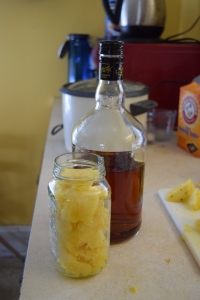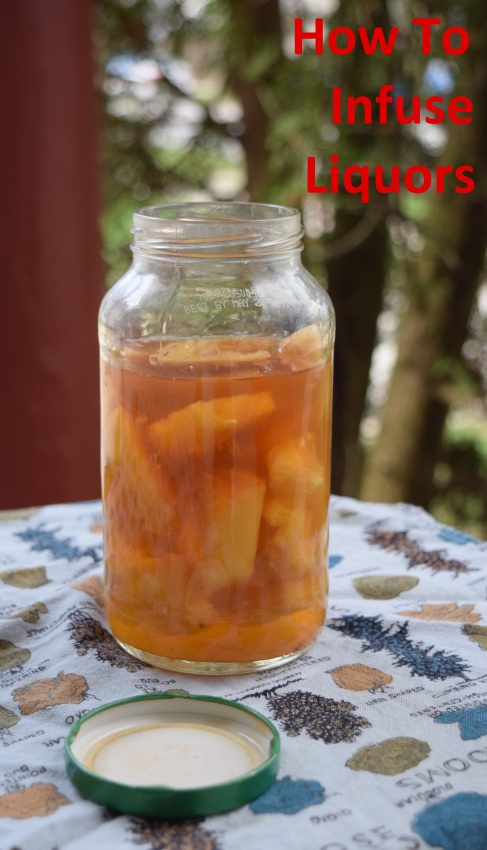The weather’s been getting warmer and it has inspired me to try to incorporate more tropical fruit into my diet in anticipation of summer. I bought a pineapple for that purpose, put it in the pantry, and promptly forgot that it existed. By the time I remembered it several days later, it was almost midnight, I was stuffed from a late night snack, and the pineapple was on the verge of going bad. So I did what any reasonable person would do- I threw it in alcohol.
Infusing liquors allows you to express your creativity before even dreaming up drinks. They can be complex, containing a varied assortment of spices and fruit, or simple, like the one I’m creating. Your options are really only limited by your imagination.
There are some guidelines to keep in mind, however.
Carefully choose your base spirit:*
All spirits have different flavors and notes. While this fact is pretty obvious when you’re looking at the difference between blanco tequila and spiced rum, it is also true within specific classifications. For example, Old Crow (a bourbon) tastes of corn, oak, and a slight fruitiness, whereas Makers Mark 46 (another bourbon) has strong flavors of caramel, vanilla, and toasted wood as well as sweet grains. Even the standard Makers Mark tastes less deep and a bit more fruity than 46. Thus, even the subcategory of bourbon can have very disparate flavors.

Therefore, it is incredibly important to be familiar with your base spirit before infusing it with other flavors. Taking time to consider all of the different flavor notes will inevitably result in a better tasting final product.
While descriptions of whole category of liquors can never be entirely accurate, a general description can give you an idea of where to start when making an infusion. If you plan on purchasing liquor for that purpose, however, make sure to read detailed reviews of the individual spirit.
I’ll acknowledge my bias and go ahead and start with my absolute favorite liquor:
Bourbon:
Bourbon is often characterized by notes of vanilla, oak, and caramel. The flavor will vary vastly depending on whether the bourbon is wheated or rye, however. Rye will be spicier, and wheated will be more mild and light.
Whiskey:
Whiskey, the broad category under which bourbon falls, is a liquor made from fermented grains and aged in oak. The oak reacts with the alcohol to release flavor compounds. Whiskeys are often described as woody or having notes of vanilla.
Gin:
Gin is a clear spirit similar to vodka, but it contains a blend of herbs and aromatics, dominant of which is juniper. London dry gin is intensely perfumed with juniper, but is less dry than Plymouth gin.
Vodka:
Vodka is often used for infusions because it has essentially no flavor of its own. Therefore, it can be paired with almost anything to take on its flavor.
Rum:
Rum is most often made from molasses, a byproduct of sugar production. Two types of rum dominate the market: white and spiced. A good white rum will have a rich flavor of burnt sugar. Spiced rums are exactly as they sound. They often have flavors of cinnamon, nutmeg, and vanilla.
Tequila:
Tequila is made from the agave plant and comes in two varieties: silver and gold. Silver tends to taste strongly of agave, often with a peppery or citrusy flavor behind it. Silver will have more of an alcoholic bite to it. Gold, or aged, tequila will vary depending on whether it is reposado or añejo. Reposado will still maintain an agave flavor, but will be accompanied by notes of vanilla, oak, or honey. Añejo will take on a much different character of butterscotch, chocolate, or caramel and will not have as much of an alcoholic bite.
Decide on flavors:*
Once you have an understanding of your base spirit, think about what flavors would complement or elevate it. You can infuse liquor with a plethora of items, but fruit, herbs, and spices are most common. When working with fruit and herbs (as well as vegetables), using fresh items allows for better extraction. For spices, use unground spices to simplify the straining process.
You can infuse a spirit with just one flavor, such as pineapple, or layers of flavor, such as cinnamon, ginger, and apple. If you are infusing with different items make sure to consider the amount of time each is in the liquor.
Here is a general guideline for how long commonly infused items should be steeped:
1-4 days: Cinnamon, citrus, fresh herbs, ginger, hot peppers
3-6 days: Berries, melons, stone fruits, sweet peppers
5-7 days: Apples, cucumbers, pears, pineapple
7-10 days: Carrots, most dried spices
*These two steps might be reversed. For example, I knew that I needed to use up my pineapple, so I then tasted my spirits while considering which would go best with the pineapple.
Actually infuse:
Put ingredients into a sealable, glass container (I generally use 12 oz mason jars.) I begin by infusing the items that take longer. So, if I was making a lemon-carrot vodka, I would allow the carrot to infuse for four or five days before adding the lemon. Store it in a dark, cool but not cold area. Allow the liquor to infuse for the prescribed amount to time, tasting periodically to ensure it is progressing as you desire. If one flavor is becoming stronger than you would like, remove that item while allowing the others to remain.
Once the infusion tastes as you wish, strain first through a kitchen strainer, then through cheesecloth or a coffee filter. Bottle, allow to mellow for a day or two, and then enjoy your creation!



Just wanted to stop by and say thanks for the follow! I have always wanted to infuse liquors but have been infusing my Bloody Mary mixes instead (only for 1-3 days). I really do want to try infusing the actual liquor though, so this lovely article will help me out 🙂 Thanks for the tips.
Cheers!
-Jess (www.bloodymarytour.org)
LikeLike
Pingback: Home Bar Hacks | Drink To My Health
Pingback: DIY Presents for Your Booze Enthused Friends | Drink To My Health